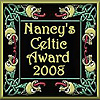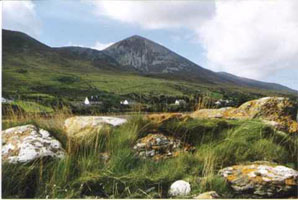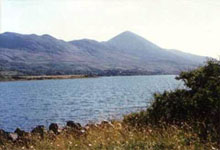| |

Traditions, folklore, history and more. If it's Irish, it's here. Or will be!
"People will not look forward to posterity who never look backward to their ancestors."
-Edmund Burke




Quotes
Library: Books, Movies, Music
Prints & Photos
Poetry
Jokes


Shops Ireland
Bunús na Gaeilge
(Basic Irish)
Circle of Prayer
Blessings
Did You Know?
Himself/Herself
Write to Us
Readers Write..
Links/Link to Us
Advertise with us
Awards & Testimonials
Submissions Guide


|
|
|
He Came To Mock - But Stayed to Pray
by Bridget Haggerty
 The title for this article is an old Irish saying about "The Reek" - Croagh Patrick. It was once known as Crochan Aigh, the mount of the eagle, before it became associated with Ireland's best-loved saint. The title for this article is an old Irish saying about "The Reek" - Croagh Patrick. It was once known as Crochan Aigh, the mount of the eagle, before it became associated with Ireland's best-loved saint.
According to legend, St. Patrick retired to the summit of Croagh Patrick for contemplation, fasting and prayer. He remained there for forty days and forty nights during which he was tormented by demons who assumed the form of black birds. He rang his bell so loudly that the men of Ireland heard it; finally he threw the bell at the demons so hard that it broke and the blackbirds departed. Patrick wept and an angel came to console him. As the story goes, he asked the angel to intercede on behalf of the Irish people and secure special dispensations for them.
The mountain is in Co. Mayo, about five miles outside the town of Westport. At 2510 feet above sea level, it soars majestically over the town, but more often than not, its summit is hidden in the clouds. Long before the arrival of Christianity to Ireland, history tells us that the summit was occupied by a hill fort, complete with stone ramparts and dwellings. Excavations have been carried out and among the earliest dateable finds are beads from the 3rd century B.C.
On the outskirts of the rampart on the mountain slopes, the outline of at least thirty hut sites have been detected. Another recent survey is uncovering a wide range of newly discovered monuments throughout the mountain and around it. These include ancient cooking sites, megalithic tombs, standing stones, burial mounds, ring forts, monastic sites and children’s burial grounds.
It is said that St. Patrick established a rude chapel on the summit called Teampall Phadraig. Through carbon dating, proof of the existence of this chapel was found in 1994. There is also evidence of the chapel’s existence recorded in 824 when the Archbishop of Armagh had an argument with the Archbishop of Tuam as Armagh was claiming church dues from Teampall Phadraig. This shows that the chapel on the summit was in use. The foundations, built around 432 are still on the summit of ‘The Reek’.
Today, thousands of pilgrims follow in Patrick's footsteps and many of them make the trek on Garland Sunday, the last Sunday in July. Pilgrims attend Mass, receive confession and pray at St Patrick's Bed on the summit. Hundreds make the ascent in their bare feet and, up until 1974 when the Church officially discouraged it, the pilgrims climbed right through the night to watch the morning sunrise at the top. This was a wondrous sight to behold as thousands of moving lights slowly made their way in an ascending column that was almost three miles long.
Garland Sunday is one of three official Pilgrimage Days and coincides with Lughnasa, which was the beginning of the harvest festival in honor of the god Lugh. Lugh was the ancient God of the Tuatha De Danann, the divine Irish Race. The Festival of Lughnasa was celebrated throughout Ireland and observance of it was thought to be critical for the success of the harvest. This tradition was absorbed into Christian beliefs, but there are still a lot of old sayings in existence that hark back to the ancient traditions. One very common one in the west of Ireland is that the potatoes are not to be harvested until after ‘Reek Sunday’.
 The other traditional Pilgrimage days are the last Friday of July which is known locally as 'Garland Friday', and August 15th which is the Feast of the Assumption of Our Lady into Heaven. On these days, services are available on the summit of the mountain. While these are the "official" Pilgrimage times, there is hardly a day of the year when there isn't somebody climbing Croagh Patrick for their own reasons, be they nature lovers, hill climbers, pilgrims, historians or just a curious tourist. However, it's on the official treks that you're likely to see an ironic twist taking place along the route. We found the following article written by Frank McNally, a Westport journalist. Here's what he wrote about one Garland Sunday Pilgrimage: The other traditional Pilgrimage days are the last Friday of July which is known locally as 'Garland Friday', and August 15th which is the Feast of the Assumption of Our Lady into Heaven. On these days, services are available on the summit of the mountain. While these are the "official" Pilgrimage times, there is hardly a day of the year when there isn't somebody climbing Croagh Patrick for their own reasons, be they nature lovers, hill climbers, pilgrims, historians or just a curious tourist. However, it's on the official treks that you're likely to see an ironic twist taking place along the route. We found the following article written by Frank McNally, a Westport journalist. Here's what he wrote about one Garland Sunday Pilgrimage:
Evangelists trying to reroute pilgrimage
"The annual pilgrimage to Croagh Patrick is becoming a bit like the Northern parades issue in reverse. On one side thousands of people, mostly Catholics, mark a Sunday in July by walking a traditional route to and from a church on top of a hill. On the other, a small but growing number of evangelists, mostly Protestants, line the approach to the mountain, arguing that if the pilgrims are really interested in going to heaven, they need to get rerouted fast.
It's a very polite standoff. The evangelists are armed only with Bible tracts, most of them with contact addresses in places such as Ballyclare, Bushmills and Poyntzpass, and all with the gentle but firm message that salvation is won by faith alone and climbing mountains doesn't improve your chances.
The pilgrims take the hand-outs politely and keep climbing. But there were some tensions. Mrs Helen Bradford from Portadown was explaining to The Irish Times that a person might find God "at home in the living room" as quickly as on top of a mountain, when a middle-aged man shouted: "Go back up to the North and preach to some of your friends up there, (expletive) rubbish!"
That was unusual, she said. Most of the climbers were nice, if misguided. "I ask them all if they're happy, but none of them are any happier coming down than when they went up. The only happy people I've met here are the ones handing out Bible tracts."
This may be true, but pilgrims who arrived in the afternoon were at least happier than those who'd come early. The morning was wet and cold, reducing visibility on the Reek to 50 metres or less and blotting out any view from the summit. The rain made the rocks and scree on the final approach treacherous, and the combined Order of Malta/Mountain Rescue operation was kept busy.
Even though they are discouraged by the church, night climbs continue on the Reek. A married couple got into trouble near the summit just before midnight on Saturday and had to be helped down. A number of others were stretchered off the peak yesterday morning, but most casualties were "walking wounded", according to Éamonn Berry, who was co-ordinating the rescue effort. "Mostly it's just people with cuts and bruises."
The most colourful figure on the mountain yesterday was a man from Fermanagh. Looking not unlike St Patrick himself, he sported a long, red-grey beard, a poncho and rolled-up trouser legs and carried a heavy wooden pole with a shamrock-shaped placard bearing spiritual messages. He declined to be identified, on the grounds that "the message is more important than the messenger". But describing himself as a "consecrated lay person and family man", he spoke passionately about his beliefs and "the insanity of the world"."That's what this mountain is about," he said, as he began his ascent. "Our struggle is to get to the top, so that we can enter into God's plan. We are told we will find God at the top of the mountain. But we have to battle constantly with the ways of the world to get there."
A few hundred feet up, he was battling with the ways of the evangelists. A spirited but polite theological debate with two of his fellow Northerners was followed by a more robust exchange with a larger group of leafleteers. Then, a little further up, he ran into Mrs Bradford, who inquired if he was happy, and soon looked like she was sorry for asking. The Fermanagh man had a mountain to climb, but he was in no hurry.
For most pilgrims, however, the great debating issue was whether it was harder going down than going up. At the summit, up above the evangelist line, visibility was improving and spirits improved with it. The sun burned through the mist around noon and, whatever about seeing the truth, late arrivals were treated to stunning views of Clew Bay and Connemara.
 Demand for £2 cups of soup waned, and £1.50 drink cans were doing brisk business at the stalls dotting the route. Back at the base in Murrisk, a stand was offering thermal socks to those going up and St Patrick souvenir mugs to those who'd finished. Hot dogs, whipped ices and "I climbed Croagh Patrick" certificates (£2) were also for sale. But volunteers at a Bible stand welcomed the returning climbers with free soft drinks, all of them orange. Demand for £2 cups of soup waned, and £1.50 drink cans were doing brisk business at the stalls dotting the route. Back at the base in Murrisk, a stand was offering thermal socks to those going up and St Patrick souvenir mugs to those who'd finished. Hot dogs, whipped ices and "I climbed Croagh Patrick" certificates (£2) were also for sale. But volunteers at a Bible stand welcomed the returning climbers with free soft drinks, all of them orange.
So, even on the sacred mountain of Croagh Patrick, the religious differences that have torn the North apart are now creating tense situations as pilgrims make their way up and down. Would that St. Patrick could have his angel intercede once more and ask God to grant peace in Ireland during our lifetime. Sadly, it looks as if it will take a miracle of that magnitude."
Images: Images.ireland.com
|
|
Fri, Sep 27, 2024
 The Galway Hooker The Galway Hooker
This unique vessel, with its distinctive curved lines and bright red sails, originated in the village of Claddagh. During the 19th century, hookers supported a significant fishing industry and also carried goods, livestock and fuel. Seán Rainey is remembered for building the last of the original boats, the Truelight, for Martin Oliver who was to become the last king of the Claddagh; as king, he was entitled to white sails on his boat. Since the mid seventies, many of the old sailing craft which were on the verge of extinction have been lovingly restored and new ones have been built. During the summer months they can be seen at festivals such a Cruinniú na mBád - the Gathering of the Boats - in Kinvara.
Click for More Culture Corner.
A magnificent pictorial tribute to the splendor of Irish gardens, featuring more than 200 color images.
Eclare ushers readers into spectacular Irish garden settings...
Equally captivating are the book's gorgeous photographs of plants, beautiful stonework, outstanding statuary, and the voluptuous floral compositions that adorn Ireland's great castle estates, rural herb growers, country guest houses, and quaint cottages.
Alice Joyce
Click for Glorious Gardens.
|
|
|
|
|




 The Galway Hooker
The Galway Hooker